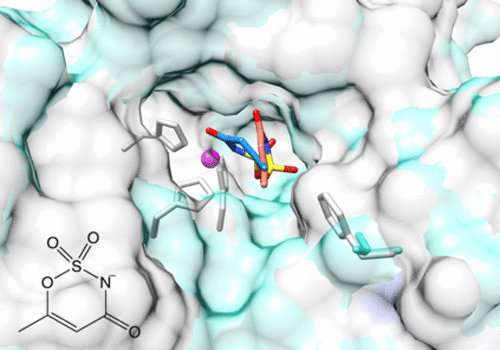Artificial sweetener could someday provide cancer treatments with fewer side effects

Artificial sweeteners are used in diet drinks and foods but also could someday be used as treatments targeting carbonic anhydrase IX (CA IX), a protein associated with aggressive cancers. Although several drugs have been approved that target similar forms of CA, they aren't selective and may cause side effects, including vomiting and fatigue. Now researchers report in ACS' Journal of Medicinal Chemistry that an artificial sweetener could lead to development of a more selective therapy.
CA IX is a zinc protein that is typically found only in the gastrointestinal tract, but it is overexpressed in cancer tissues and contributes to the growth and spread of malignant cells in lung, brain and breast cancers. But the body produces 14 other forms of CA proteins that are involved in the function of normal, healthy cells. In earlier work, Robert McKenna and colleagues reported that saccharin, the artificial sweetener in Sweet'N Low, was more selective toward CA IX than other treatments and therefore could be a promising treatment option. But the team wanted to know if another artificial sweetener, acesulfame potassium, would be an even better cancer treatment. Known as ACE K, this sweetener is marketed as Sunett and Sweet One and is already widely consumed in processed foods like sodas and baked goods.
The CA IX protein is difficult to purify, so the researchers created a genetically engineered version, called "CA IX mimic." They then studied the interactions of ACE K and other inhibitors with CA IX mimic and with a form found throughout the body called CA II. They determined that ACE K is more selective than saccharin, vastly preferring CA IX over CA II. They also explored the characteristics about ACE K binding to CA IX that makes it unique compared to other inhibitors. For example, ACE K completely fills the CA IX binding site and binds directly to a catalytic zinc ion, displacing a water molecule that is still present when approved drugs bind. This information will help researchers modify ACE K's chemical structure to create even more selective treatments that have fewer side effects.
More information: Akilah B. Murray et al. "Seriously Sweet": Acesulfame K Exhibits Selective Inhibition Using Alternative Binding Modes in Carbonic Anhydrase Isoforms, Journal of Medicinal Chemistry (2017). DOI: 10.1021/acs.jmedchem.7b01470
Abstract
Human carbonic anhydrase IX (CA IX) is upregulated in neoplastic tissues; as such, it is studied as a drug target for anticancer chemotherapy. Inhibition of CA IX has been shown to be therapeutically favorable in terms of reducing tumor growth. Previously, saccharin, a commonly used artificial sweetener, has been observed to selectively inhibit CA IX over other CA isoforms. In this study, X-ray crystallography showed acesulfame potassium (Ace K) binding directly to the catalytic zinc in CA IX (mimic) and through a bridging water in CA II. This modulation in binding is reflected in the binding constants, with Ace K inhibiting CA IX but not other CA isoforms. Hence, this study establishes the potential of Ace K (an FDA approved food additive) as a lead compound in the design and development of CA IX specific inhibitors.
Journal information: Journal of Medicinal Chemistry
Provided by American Chemical Society




















